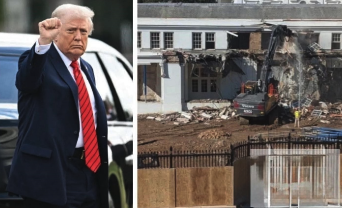White House Pushes Back Against Democratic Criticism Over Trump’s Ballroom Renovation
The White House is actively defending President Donald Trump’s decision to construct a new ballroom at the presidential residence, responding to a wave of Democratic criticism that the project is unnecessary and ostentatious. The administration emphasizes that the privately funded $250 million initiative aims to modernize the historic complex and improve functionality, without using taxpayer dollars.
A Privately Funded Addition
White House officials note that the ballroom, sited on the South Lawn, is entirely financed through private donations. The space is designed to host state events, press briefings, and official ceremonies, allowing the East Wing to continue daily operations without disruption.
“This project isn’t about luxury — it’s about practicality and modernization,” a senior official said. “It’s being paid for privately, and it’s going to serve the American people by improving how the White House functions.”
Despite these assurances, the project has drawn sharp criticism from Democrats, who argue that the timing and symbolism of the addition are insensitive amid ongoing fiscal debates and a government funding standoff. Progressive activists online mocked the project as an act of vanity, dubbing it “Trump Tower 2.0.”
Comparisons to Past Renovations
White House aides quickly pushed back, pointing out that similar renovations under previous Democratic administrations received far less scrutiny. One spokesperson highlighted the contrast with the $350 million taxpayer-funded renovations during President Obama’s tenure, which included extensive security and technological upgrades. Archival footage and contemporary reports praised these improvements at the time, further fueling the administration’s argument about “selective outrage.”
“The irony is striking,” the spokesperson said. “Presidents before Trump upgraded the White House using public funds. President Trump is upgrading it using private donations. That’s the difference.”
Supporters echoed the sentiment online, framing the project as an example of private-sector efficiency applied to government institutions. “Democrats have no problem when billions go to vanity projects in blue cities,” one commentator wrote. “But they lose their minds over a privately funded ballroom? Give me a break.”
Symbolism and Perception
Critics contend the ballroom reinforces Trump’s image as a businessman-turned-president more focused on personal legacy than public service. “It’s about priorities,” said a Democratic strategist. “Americans are struggling with inflation, and this sends the wrong message.”
Conversely, supporters argue that the project reflects Trump’s long-standing emphasis on self-sufficiency and private initiative. “The same people who accuse him of being a dictator are now upset that he didn’t use government funds,” said a conservative analyst. “The outrage doesn’t make sense.”
Historical Context
Historians note that the White House has undergone continuous expansion and modernization for over two centuries. Theodore Roosevelt oversaw the creation of the West Wing in 1902, Harry Truman conducted a complete structural overhaul in the 1940s, and John F. Kennedy led extensive interior redesigns during his presidency.
“Each generation leaves its mark on the White House,” said historian Margaret Vaughn. “The outrage tends to fade once people see how these updates become part of the institution’s history.”
Political Theater or Policy Distraction?
Analysts suggest that much of the current debate is symbolic, reflecting the polarized political environment rather than substantive concerns about the building itself. Democrats use the project to frame Trump as out of touch, while Republicans highlight perceived hypocrisy over past Democratic renovations.
“This is the new normal,” said political analyst Jason King. “Every move is politicized, every gesture dissected, and every president becomes a lightning rod — even over something as mundane as construction plans.”
A Pattern of Controversy and Support
Trump’s political career has repeatedly demonstrated how controversy can bolster support among his base. Each accusation of excess or ego tends to reinforce loyalty and energize supporters.
Construction on the ballroom continues, with White House officials confident that the project’s purpose and legacy will eventually be recognized.
“When it’s finished,” one aide said, “people will see that this isn’t about luxury — it’s about legacy. Every president leaves something behind. This will be one of those things.”

